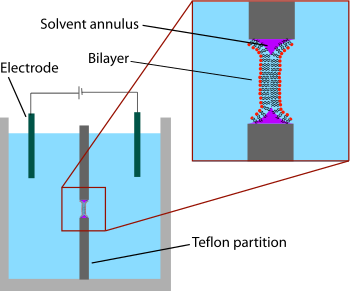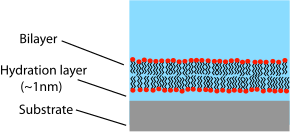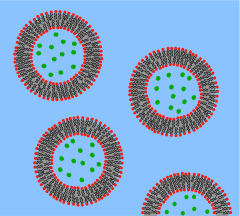Model lipid bilayer
A model lipid bilayer is any bilayer assembled in vitro, as opposed to the bilayer of natural cell membranes or covering various sub-cellular structures like the nucleus. They are used to study the fundamental properties of biological membranes in a simplified and well-controlled environment, and increasingly in bottom-up synthetic biology for the construction of artificial cells.[1] A model bilayer can be made with either synthetic or natural lipids. The simplest model systems contain only a single pure synthetic lipid. More physiologically relevant model bilayers can be made with mixtures of several synthetic or natural lipids.
There are many different types of model bilayers, each having experimental advantages and disadvantages. The first system developed was the black lipid membrane or “painted” bilayer, which allows simple electrical characterization of bilayers but is short-lived and can be difficult to work with. Supported bilayers are anchored to a solid substrate, increasing stability and allowing the use of
Black lipid membranes (BLM)

The earliest model bilayer system developed was the “painted” bilayer, also known as a “black lipid membrane.” The term “painted” refers to the process by which these bilayers are made. First, a small aperture is created in a thin layer of a hydrophobic material such as
After allowing the aperture to dry, salt solution (aqueous phase) is added to both sides of the chamber. The aperture is then "painted" with a lipid solution (generally the same solution that was used for pre-painting). A lipid monolayer spontaneously forms at the interface between the organic and aqueous phases on either side of the lipid/solvent droplet. Because the walls of the aperture are hydrophobic the lipid/solvent solution wets this interface, thinning the droplet in the center. Once the two sides of the droplet come close enough together, the lipid monolayers fuse, rapidly excluding the small remaining volume of solution. At this point a bilayer is formed in the center of the aperture, but a significant annulus of solvent remains at the perimeter. This annulus is required to maintain stability by acting as a bridge between the ~5 nm bilayer and the tens of micrometers thick sheet in which the aperture is made.[3]
The term “black” bilayer refers to the fact that they are dark in reflected light because the thickness of the membrane is only a few nanometers, so light reflecting off the back face destructively
The main problems associated with painted bilayers are residual solvent and limited lifetime. Some researchers believe that pockets of solvent trapped between the two bilayer leaflets can disrupt normal protein function. To overcome this limitation, Montal and Mueller developed a modified deposition technique that eliminates the use of a heavy non-volatile solvent. In this method, the aperture starts out above the water surface, completely separating the two fluid chambers. On the surface of each chamber, a monolayer is formed by applying lipids in a volatile solvent such as chloroform and waiting for the solvent to evaporate. The aperture is then lowered through the air-water interface and the two monolayers from the separate chambers are folded down against each other, forming a bilayer across the aperture.[8] The stability issue has proven more difficult to solve. Typically, a black lipid membrane will survive for less than an hour, precluding long-term experiments. This lifetime can be extended by precisely structuring the supporting aperture,[9] chemically crosslinking the lipids or gelling the surrounding solution to mechanically support the bilayer.[10] Work is ongoing in this area and lifetimes of several hours will become feasible.
Supported lipid bilayers (SLB)

Unlike a vesicle or a cell membrane in which the lipid bilayer is rolled into an enclosed shell, a supported bilayer is a planar structure sitting on a solid support. Because of this, only the upper face of the bilayer is exposed to free solution. This layout has advantages and drawbacks related to the study of lipid bilayers. One of the greatest advantages of the supported bilayer is its stability. SLBs will remain largely intact even when subject to high flow rates or vibration and, unlike black lipid membranes, the presence of holes will not destroy the entire bilayer. Because of this stability, experiments lasting weeks and even months are possible with supported bilayers while BLM experiments are usually limited to hours.[11] Another advantage of the supported bilayer is that, because it is on a flat hard surface, it is amenable to a number of characterization tools which would be impossible or would offer lower resolution if performed on a freely floating sample.
One of the clearest examples of this advantage is the use of mechanical probing techniques which require a direct physical interaction with the sample.
Many modern fluorescence microscopy techniques also require a rigidly-supported planar surface.

Another important capability of supported bilayers is the ability to pattern the surface to produce multiple isolated regions on the same substrate. This phenomenon was first demonstrated using scratches or metallic “corrals” to prevent mixing between adjacent regions while still allowing free diffusion within any one region.[23][24] Later work extended this concept by integrating microfluidics to demonstrate that stable composition gradients could be formed in bilayers,[25] potentially allowing massively parallel studies of phase segregation, molecular binding and cellular response to artificial lipid membranes. Creative utilization of the corral concept has also allowed studies of the dynamic reorganization of membrane proteins at the synaptic interface.[26]
One of the primary limitations of supported bilayers is the possibility of unwanted interactions with the substrate. Although supported bilayers generally do not directly touch the substrate surface, they are separated by only a very thin water gap. The size and nature of this gap depends on the substrate material
Unwanted substrate interactions are a much greater problem when incorporating integral membrane proteins, particularly those with large domains sticking out beyond the core of the bilayer. Because the gap between bilayer and substrate is so thin these proteins will often become denatured on the substrate surface and therefore lose all functionality.[31] One approach to circumvent this problem is the use of polymer tethered bilayers. In these systems the bilayer is supported on a loose network of hydrated polymers or hydrogel which acts as a spacer and theoretically prevents denaturing substrate interactions.[32] In practice, some percentage of the proteins will still lose mobility and functionality, probably due to interactions with the polymer/lipid anchors.[30] Research in this area is ongoing.
Tethered bilayer lipid membranes (t-BLM)
The use of a tethered bilayer lipid membrane (t-BLM) further increases the stability of supported membranes by chemically anchoring the lipids to the solid substrate.
The limitation of the intra-membrane mobility of supported lipid bilayers can be overcome by introducing half-membrane spanning tether lipids[34] with benzyl disulphide (DPL) and synthetic archaea analogue full membrane spanning lipids with phytanoly chains to stabilize the structure and polyethyleneglycol units as a hydrophilic spacer. Bilayer formation is achieved by exposure of the lipid coated gold substrate to outer layer lipids either in an ethanol solution or in liposomes.[35]
The advantage of this approach is that because of the hydrophilic space of around 4 nm, the interaction with the substrate is minimal and the extra space allows the introduction of protein ion channels into the bilayer. Additionally the spacer layer creates an ionic reservoir[36] that readily enables ac electrical impedance measurement across the bilayer.
Vesicles

A vesicle is a lipid bilayer rolled up into a spherical shell, enclosing a small amount of water and separating it from the water outside the vesicle. Because of this fundamental similarity to the cell membrane, vesicles have been used extensively to study the properties of lipid bilayers. Another reason vesicles have been used so frequently is that they are relatively easy to make. If a sample of dehydrated lipid is exposed to water it will spontaneously form vesicles.[37] These initial vesicles are typically multilamellar (many-walled) and are of a wide range of sizes from tens of nanometers to several micrometres.[38] Methods such as sonication or extrusion through a membrane are needed to break these initial vesicles into smaller, single-walled vesicles of uniform diameter known as small unilamellar vesicles (SUVs). SUVs typically have diameters between 50 and 200 nm.[39] Alternatively, rather than synthesizing vesicles it is possible to simply isolate them from cell cultures or tissue samples.[40] Vesicles are used to transport lipids, proteins and many other molecules within the cell as well as into or out of the cell. These naturally isolated vesicles are composed of a complex mixture of different lipids and proteins so, although they offer greater realism for studying specific biological phenomena, simple artificial vesicles are preferred for studies of fundamental lipid properties.
Since artificial SUVs can be made in large quantities they are suitable for bulk material studies such as
In spite of the fluorescent labeling, it is often difficult to perform detailed imaging on SUVs simply because they are so small. To combat this problem, researchers use giant unilamellar vesicles (GUVs). GUVs are large enough (1 - 200 µm) to be studied using traditional fluorescence microscopy and are within the same size range as most biological cells. Thus, they are used as mimicries of cell membranes for in vitro studies in molecular and cell biology. Many of the studies of
Droplet Interface Bilayers
Droplet Interface Bilayers (DIBs) are phospholipid-encased droplets that form bilayers when they are put into contact.[48][49] The droplets are surrounded by oil and phospholipids are dispersed in either the water or oil.[48] As a result, the phospholipids spontaneously form a monolayer at each of the oil-water interfaces.[48] DIBs can be formed to create tissue-like material with the ability to form asymmetric bilayers, reconstitute proteins and protein channels or made for use in studying electrophysiology.[50][51][52][53][54] Extended DIB networks can be formed either by employing droplet microfluidic devices or using droplet printers.[54][55]
Micelles, bicelles and nanodiscs
Bicelles are a related class of model membrane,
References
- PMID 28580796.
- S2CID 2110051.
- PMID 5019479.
- S2CID 34363724.
- .
- PMID 6188500.
- PMID 19066527.
- PMID 4509315.
- PMID 18370435.
- .
- .
- PMID 16214871.
- PMID 18254602.
- S2CID 20571172.
- PMID 16617084.
- PMID 10753119.
- .
- PMID 18422336.
- PMID 24251388.
- PMID 26401022.
- PMID 15697284.
- PMID 9649391.
- S2CID 30939780.
- .
- .
- .
- PMID 18942863.
- .
- PMID 2009353.
- ^ PMID 7918990.
- PMID 32287559.
- PMID 10465756.
- .
- S2CID 4348659.
- .
- PMID 11498038.
- PMID 14187392.
- PMID 3066342.
- ^ F Szoka and D Papahadjopoulos."Comparative Properties and Methods of Preparation of Lipid Vesicles (Liposomes)." Annual Review of Biophysics and Bioengineering. 9. (1980) 467-508.
- PMID 3380805.
- PMID 4167394.
- .
- PMID 17092481.
- PMID 12944275.
- PMID 11222302.
- S2CID 232131463.
- PMID 21309555.
- ^ PMID 19396383.
- PMID 17165804.
- PMID 18407631.
- PMID 21591742.
- PMID 26348441.
- PMID 21978255.
- ^ PMID 23559243.
- PMID 28417964.
- PMID 15519311.
- S2CID 22774774.
- PMID 19903557.
- PMID 24395412.
- S2CID 207503256.
